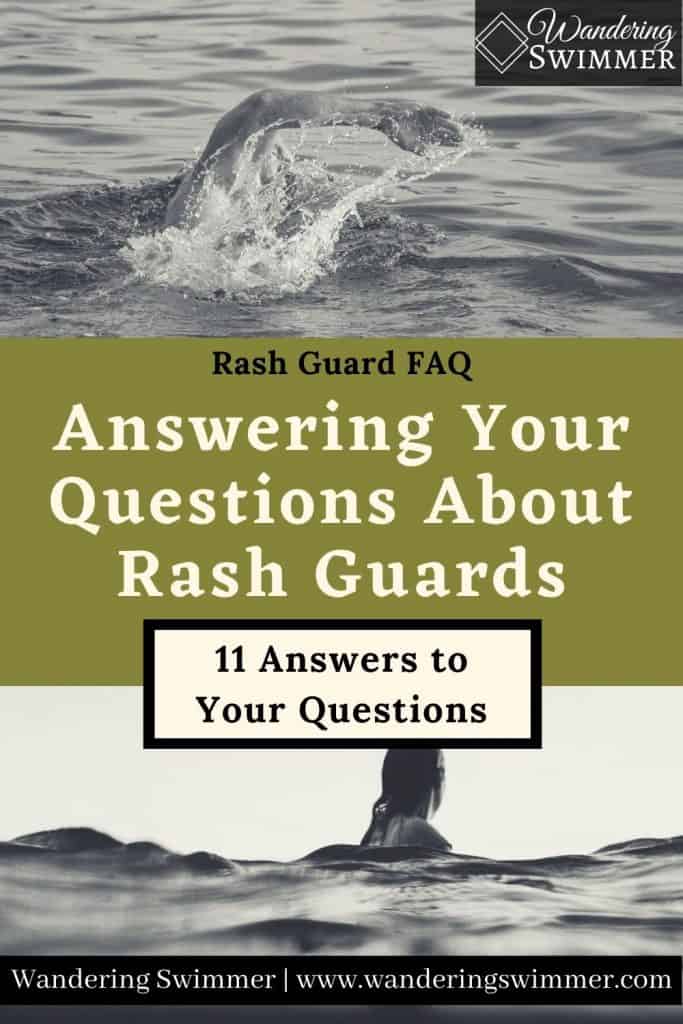Typically, rash guards are used in open water sports, such as open water swimming, surfing, or snorkeling. However, it doesn’t mean that you can’t use a rashguard while swimming laps.
Yet for all their benefits, not a lot of people know about rash guards. Let alone why they should wear them and who can wear them?
In this article, we’ll discuss what a rash guard is and why you should wear one the next time you’re out in the sun!
Disclosure: This post may contain affiliate links, meaning I earn a small commission at no cost to you if you purchase something through one of my links. As an Amazon Associate, I earn from qualifying purchases. Please check out my disclosure page for more information.

What is a Rash Guard?
Originally developed for surfers, a rash guard is an athletic shirt that is designed to be used in the water without restricting too much motion. This is done by using flatlock stitching so that the seams fit tighter to the body.
They come in a long or short sleeve style, enabling the user to use them through different seasons. Made of spandex, nylon, or polyester, rash guards are typically lightweight and can dry quickly. Rash guards can also be made of neoprene to help provide warmth for cold water.
You might hear them referred to as a rash vest or a rashie 🙂
What Does a Rash Guard Do?
As the name applies, rash guards help protect the user from rashes! Primarily, they protect the skin not just from rashes, but also from chafing and UV rays.
Certain rash guards can also offer insulation and warmth for cold weather and water. And when bright enough, they can provide a means of safety for anyone in the water.
Surfers primarily use them as a means to prevent chafing caused by the board and sand. Whereas swimmers use them to protect against the sun and potential irritation caused by a wetsuit.
Why are Rash Guards Better than T-Shirts?
We know what you’re thinking. Why can’t I just wear a regular t-shirt instead or a rash guard?
One of the problems with wearing a t-shirt in the water is that the fabric isn’t the best in the water. Ever get caught in the rain or got your t-shirt wet somehow? If so, then you know a wet shirt can get heavy as it holds the water in the fabric.
And the last thing you want is to wear something heavy when you’re in the water. Or near the water, for that matter.
While on the subject of fabric.
The fabric that makes up a rash guard is designed for the water. So it doesn’t stretch out as quickly as the material in a t-shirt does. The thin fabric allows rash guards to dry much quicker than t-shirts, which reduces any bacteria buildup.
T-shirts also tend to hold air and balloon out in the water. This makes it more difficult to move around in the water and decreases your range of motion.
Benefits of Rash Guards
From protecting from abrasions to providing modesty, rash guards offer a plethora of benefits for those who use them. Some other benefits of rash guards are:
- Help prevent sunburns from extended sun exposure
- Prevent rashes, irritation, and chafing while surfing
- Offers protection from chafing when wearing a wetsuit
- An alternative to wearing a wetsuit in warm weather
- Can provide some warmth in cooler water/temperatures (if wearing a thermal/neoprene rash guard)
- Provides modesty and can be worn over a swimsuit
- Bright colors can provide safety when in the water
- Can be used by anyone
Can You Swim in a Rash guard?
You can! Because rash guards fit tight to the body, you’ll find that your movement isn’t overly restricted.
Some swimmers prefer a short sleeve rash guard to a long sleeve for better shoulder movement. But you can still swim if you wear a long sleeve rash guard.
Can I Wear a Rash Guard at the Pool?
Yes, you can! Whether the pool is an indoor or outdoor pool, you can still wear a rash guard at the pool.
Although several of the benefits of a rash guard are for outdoors (UV protection, irritation from sand and waves, etc.), it doesn’t mean that you can’t wear one at an indoor pool. They still provide modesty and coverage for those who prefer their body a little more covered.
How Should a Rash Guard Fit?
This depends on your preference. To be most effective, rash guards should fit tight against the body. But they shouldn’t fit so tightly that they restrict your movement.
When you try one on, make sure you test out the range of motion with your arms. If you plan to swim with one, run through the motions of a few strokes. If you feel that you can’t move properly, you might need a larger size.
Rash Guards vs Swim Shirts
What is the difference between rash guards and swim shirts? Glad you asked!
The biggest difference is the fit. Swim shirts tend to fit a little looser to the body. Whereas a rash guard will fit tighter to the body. With the looser fit and style, it’s more comfortable for some individuals to wear a swim shirt.
Aside from the looser fit, swim shirts offer the same benefits as rash guards.
Because of this, a swim shirt can be used for more than just water sports. You can use swim shirts for other outdoor activities, such as hiking, gardening, spending time on the river, or playing on the beach.
Rash Guards
Swim Shirts
Should I Get a Rash Guard or Swim Shirt?
Much like the fit, this comes down to your preference. You should also consider the type of activity, the water temperature, and it’s purpose.
Consider wearing a rash guard for the following:
- Certain water sports, such as surfing or even swimming
- Protection when wearing a wetsuit
- Warmth if the water is cold
- Diving (free diving, snorkeling, or scuba diving)
If you won’t be doing any of those, you can consider wearing a swim shirt, instead. Additionally, you can swim in a swim shirt, too.
Again, the choice ultimately is up to you and what you prefer. Both articles of swimwear offer the same benefit of UV protection.
What Should I Wear Under a Rash Guard?
For women, we recommend wearing a swimsuit underneath a rash guard. Or a swim shirt, for that matter.
While rash guards can offer some compression based on the type, it might not offer the needed support or coverage.
Instead, women can wear any type of swimsuit under a rash guard.
It doesn’t matter if it’s a one-piece, two-piece top, or even a tankini. We wouldn’t recommend a bra of any type, simply because the fabric isn’t the best at holding up against chlorine or saltwater.
Men don’t need to wear anything under a rash guard or a swim shirt.
Can Kids Wear Rash Guards?
Absolutely! Toddlers, kids, and teens can all wear rash guards or swim shirts based on their needs and preference. Rash guards and swim shirts are perfect for kids (and yourself) who can’t wear sunscreen due to allergies.
Kids can also wear rash guards (or swim shirts) for swim lessons if they don’t feel comfortable in just their suit. This can give them an extra layer of confidence. Without impeding their motion while trying to swim.
As always, to happy swimming!
Chevron
Bonus Content:
Swimming Basics to Get You Started: If you just started to swim, you might feel that swimming can be overwhelming. Here are some swimming basics to help you feel more comfortable at the pool.
Swimming on Your Period FAQ: Yes, you can swim on your period! From one menstruating swimmer to another, here are some frequently asked questions about swimming on your period.

Want to Improve at the Pool?
Join swimmers and swim parents to receive my free newsletter and receive a free Swimming Glossary e-book as a thanks!
Every month you’ll receive tips and coaching to help you find success at the pool.